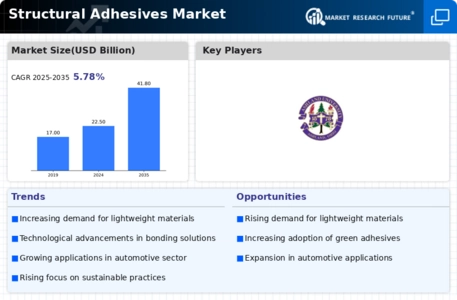Top Industry Leaders in the Structural Adhesives Market

Structural adhesives, the silent heroes of modern construction and engineering, hold the world together, one seam at a time. These versatile agents offer exceptional strength, durability, and resistance to heat, chemicals, and vibration, binding diverse materials from steel and concrete to wood and composites. Let's delve into the adhesive factors, strategic maneuvers, and recent advancements shaping this dynamic landscape.
Strategies Sticking Around:
- Product Diversification: Leading players like Henkel are expanding beyond traditional epoxy and polyurethane adhesives to develop specialized options like UV-curable and hybrid adhesives, catering to specific application needs and offering faster curing times.
- Sustainability Focus: Green bonds are forming. Companies like 3M are investing in research and development of bio-based adhesives derived from renewable resources like soybeans, aligning with environmental concerns and regulations.
- Technological Innovation: R&D labs are bubbling with concoctions. DowDuPont Inc. is pioneering conductive adhesives for electronics applications, while Evonik Industries is developing self-healing adhesives that repair minor cracks and extend product lifespan.
- Regional Expansion: Asia-Pacific, with its booming construction and automotive industries, holds immense potential. Companies like Sika AG are setting up production facilities in this region to capitalize on the local demand.
- Strategic Partnerships: Collaboration strengthens the bond. For instance, H.B. Fuller partnered with a leading aerospace manufacturer to develop customized heat-resistant adhesives for aircraft components, cementing both companies' positions in demanding applications.
Factors Dictating Market Share:
- Performance Prowess: Superior bond strength, flexibility, durability, and resistance to environmental factors are crucial metrics. Established brands like Huntsman Corporation have built reputations for reliable performance, attracting loyal customers in critical infrastructure and automotive applications.
- Cost-Effectiveness: Price remains a sticky point, particularly in mature markets. Chinese manufacturers often offer lower prices, challenging established players to optimize production and pricing strategies while maintaining quality.
- Regulatory Landscape: Stringent regulations on volatile organic compounds (VOCs) and hazardous materials dictate industry practices. Players who comply with these regulations, like Illinois Tool Works with its closed-loop recycling systems, gain a competitive edge.
- Application Diversity: Catering to diverse industries offers resilience. Companies with broad product portfolios like Akzo Nobel benefit from diversification, mitigating risks in saturated segments.
Key Players:
- Ried B.V. Co.
- Hubei Huitian Adhesive Enterprise Co.
- Arkema S.A.
- Scott Bader Company
- Lord Corporation
- Henkel AG & Co.
- SIKA AG
- Ashland Inc.
- The Dow Chemical Company
- 3M Company
Recent Developments:
- September 2023: DowDuPont Inc. introduces a line of conductive adhesives for printed circuit boards, enabling miniaturization and enhanced performance in electronic devices.
- October 2023: Evonik Industries partners with a research institute to develop self-healing adhesives for automotive components, promising reduced maintenance costs and extended vehicle lifespan.
- November 2023: H.B. Fuller and its aerospace partner successfully implement their customized heat-resistant adhesive in commercial aircraft, demonstrating its reliability and paving the way for wider adoption.
- December 2023: A consortium of chemical companies and universities receives government funding to develop next-generation structural adhesives with enhanced fire resistance, aiming to improve safety in buildings and transportation applications.

